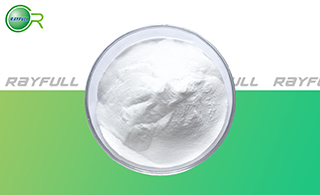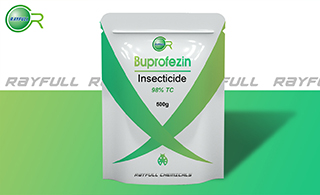Buprofezin
    噻嗪酮 噻嗪酮
Introduction: Buprofezin is an insecticide used for control of insect pests such as mealybugs, leafhoppers and whitefly on vegetable crops. It is a growth regulator, acting as an inhibitor of chitin synthesis. It is banned in some countries due to its negative environmental impacts, being especially toxic to aquatic organisms as well as non-target insects, though is of low toxicity to humans and other mammals.
Common name: Buprofezin
Another name: Applaud; Buprofezine; NNI 750; PP618; 2-((1,1-Dimethylethyl) imino)tetrahydro-3-(1-methylethyl)-5-phenyl-4H-1,3,5-thiadiazin-4-one; etc.
Chemical name:
(Z)-2-tert-butylimino-3-isopropyl-5-phenyl-1,3,5-thiadiazinan-4-one
Empirical formula: C16H23N3OS
Structural formula:

Mol. Weight: 305.44 g/mol
CAS No.: 69327-76-0
Specifications
Leading Buprofezin supplier
Buprofezin 98% TC
Buprofezin 95% TC
Buprofezin 25% WP
Packing:
BULK PACKING
Powder: 25kg/Bag, 25kg/Drum, 50kg/Drum etc.
Liquid: 200L/Drum, 20L/Drum, 10L/Drum etc.
SMALL PACKING
Powder: 1kg/Alu bag, 500g/Alu bag, 200g/Alu bag, 100g/Alu bag, 50g/Alu bag, 15g/Alu bag etc.
Liquid: 5L/Drum, 1L/Bottle, 500ml/Bottle, 250ml/Bottle, 100ml/Bottle, 50ml/Bottle etc.
Customerized packing label
Buprofezin FAO standard
Professional registration
HAZARDS IDENTIFICATION
Hazard statement(s)
H373: Causes damage to organs through prolonged or repeated exposure.
H400: Very toxic to aquatic life.
H410: Very toxic to aquatic life with long lasting effects.
Precautionary statement(s)
P260: Do not breathe dust/fume/gas/mist/vapors/spray.
P273: Avoid release to the environment.
P314: Get medical advice/attention if you feel unwell.
P391: Collect spillage.
P501: Dispose of contents/container to.
Supplemental Hazard Statements: none.
MAMMALIAN TOXICOLOGY
Acute toxicity: 1) Acute oral LD50 for rats is >2198 mg/kg. 2) Acute dermal LD50 for rats is >2000 mg/kg. 3) Acute inhalation toxicity LC50 (4 h) for rats is >4.57 mg/l. 4) Skin irritation: Non-irritating to skin (rabbits). 5) Eye irritation: Non-irritating to eyes (rabbits). 6) Skin sensitization for guinea pig: Not a skin sensitiser.
NOEL: NOEL (2 y) for rats is 0.9 mg/kg bw per day, (2 y) for mice is 17.4 mg/kg bw per day, (2 y) for dogs is 10 mg/kg bw per day. Other No evidence of carcinogenicity from animal studies.
ADI (JMPR) 0-0.009 mg/kg b.w.[2008]
Classification:
WHO Classification: III ( Slightly hazardous)
EC Risk Classification: N - Dangerous for the environment: R50, R53
US EPA Classification (formulation): III (Caution - Slightly toxic)
ECOTOXICOLOGY
Effect on birds: Acute oral LD50 for Mallard is >2000 mg/kg. Effect on fish: Acute LC50 (96 h) for Rainbow trout is >0.33 mg/l. Effects on aquatic invertebrates: Acute EC50 (48 h) for Daphnia magna is>0.42 mg/l. Effects on algae: Acute EC50 (72 h) for Pseudokirchneriella subcapitata is >2.1mg/l. Effects on bees: Contact acute (48 h) LD50 is >200 μg/bee, Oral acute (48 h) LD50 is >163.5 μg/bee. Effects on earthworms: Acute 14 day LC50 is >500 mg/kg.
ENVIRONMENTAL FATE
Animals Low residues were found in nearly all ruminant and poultry tissues. Extensive metabolism was observed, with a large number of minor metabolites being produced Plants Limited metabolism in most plant species; minor metabolites indicate a pathway involving hydroxylation or oxidative loss of the tert-butyl group, followed by opening of the heterocyclic ring. Soil/Environment DT50 (25 °C) 104 d (flooded conditions, silty clay loam, o.c. 3.8%, pH >6.4), 80 d (upland conditions, sandy loam, o.c. 2.4%, pH 7.0).
Usage: Buprofezin was developed by Nikon Nohyaku Co., Ltd.. It is a moulting inhibitor, thiadiazine insecticide for whitefly and other insect control, such as Whitefiles, Leaf- and plant-hoppers, Scale insects, Lady beetles, Mealybugs, on citrus crops, top fruit, cucumbers, tomatoes;, sweet potatoes, rice, cotton, and etc.
Application: Biochemistry Probable chitin synthesis and prostaglandin inhibitor. Hormone disturbing effect, leading to suppression of ecdysis. Mode of action Persistent insecticide and acaricide with contact and stomach action; not translocated in the plant. Inhibits moulting of nymphs and larvae, leading to death. Also suppresses oviposition by adults; treated insects lay sterile eggs. Uses Insecticide with persistent larvicidal action against Homoptera, some Coleoptera and also Acarina. Effective against Cicadellidae, Deltocephalinae (leafhoppers) and Delphacidae (planthoppers) in rice, at 50-250 g/ha; Cicadellidae (lady beetle) in potatoes; Aleyrodidae (whitefly) in citrus, cotton and vegetables, at 0.025-0.075 g/ha; Coccidae, Diaspididae (scale insects) and Pseudococcidae (mealybugs) in citrus and top fruit, at 25-50 g/hl; Tarsonemidae in vegetables, at 250-500 g/ha. Suitable for IPM programmes.
| 






